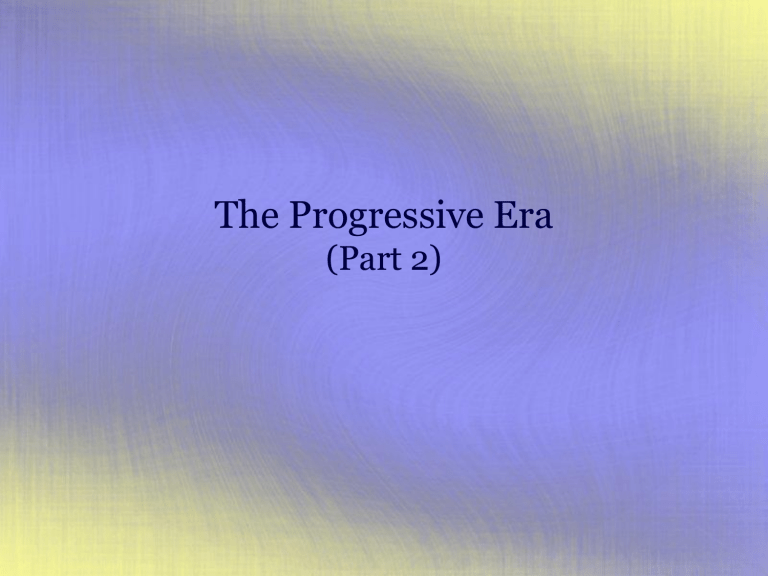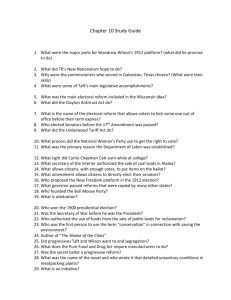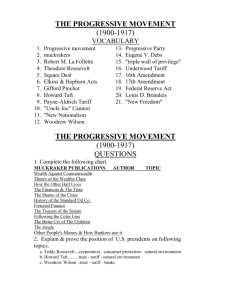The Progressive Era 2

The Progressive Era
(Part 2)
The Search for Order and Efficiency
Impose order on a chaotic society
Search for greater efficiency in business
Drive for honest, efficient, non-partisan government
The “Gospel of Efficiency”
Frederick W. Taylor – the first efficiency expert
Hoped to reduce waste by scientifically studying jobs
“Time-motion” studies
Efficient layout of workplace could reduce
Lost time
Errors
Injuries
Hoped pay incentives tied to productivity would encourage workers to exceed “average”
Very effective in rigid, standardized jobs
Workers hated it
Efficiency in Government
The “Good Government” Movement
Goals:
End political corruption
Bring efficient, business-like methods to government
Create a more compassionate legislative response to the excesses of industrialism
The “Good Government” Movement
Local Level
Blamed most of the urban problems on the “machine”
Sought to make city management:
Non-partisan, even non-political
Wanted to introduce administrative techniques developed by big business
Different organizational plans
Strong mayor
Board of Commissioners style
City manager style
Another approach was to reform the policies, not the political structure
Usually emphasized efficiency and social welfare
Typically pushed for municipal ownership of utilities
Typically set work rules for government jobs
Typically pushed for public works (parks, etc)
The Democratization of Government
(State Level)
Initiative -
Voters can place items on ballot
Referendum -
Allows voters, rather than legislature, to decide issues
Recall -
Allows removal of elected reps. w/o waiting for next election
Direct primaries –
Allows voters to select candidates (as opposed to convention system)
Pendleton Civil Service Reform Act (1883)
President to create a 3 person commission
Commission to establish standards for federal jobs
Instituted competitive examinations for candidates
Barred political candidates from soliciting contributions from government employees
Didn’t get rid of patronage, but public service did improve
Munn v. Illinois
(1876)
Established theory that private property can become
“clothed in the public interest”
Established three key principles
Right of government to regulate any business w/ a
“public interest”
Right of legislature to decide what is “fair and reasonable”
Right of states to act when Congress won’t
Wabash v. Illinois
(1886)
Limited the states’ right to regulate that had been granted in Munn
A state could only regulate traffic within its boundaries
Could not regulate traffic that crossed state lines
75% of traffic crossed state lines
Public outrage led to creation of ICC in 1887
Its power limited, the ICC was far less powerful than the big railroads
Railroads could manipulate the system and set rates at will, the ICC was irrelevant
The Progressive Presidents
Theodore Roosevelt
1901-1908
Republican
William H. Taft
1908-1912
Republican
Woodrow Wilson
1912-1920
Democrat
Roosevelt as President
“
the quintessential progressive politician”
Viewed the presidency as the “Bully Pulpit”
A platform to exhort Americans to reform their society
Believed educated & wealthy Americans had a duty to serve, guide, and inspire the less fortunate
Openly acknowledged economic and social inequalities
Believed government agencies, led by experts, could find solutions to society’s problems
The 1912 Presidential Election
Evincing the strength of the progressive ideals, all four candidates ran as “progressives”
Republican Party – Taft
Democratic Party – Wilson
Progressive Party – Roosevelt
Socialist Party - Debs
The Presidential Election of 1912
Republican Party
William Howard Taft
(Incumbent)
Graduated income tax
Safety codes for
Mines
Railroads
Restrictions on child labor
The Presidential Election of 1912
Democratic Party
Woodrow Wilson
Saw Roosevelt as main challenge
Claimed they were the “true’ progressives
State’s rights
Small government
Ambiguous reform proposals
(equality of economic oppprtunity)
The Presidential Election of 1912
Progressive Party
(a.k.a. “Bull Moose” party)
Theodore Roosevelt
Women's suffrage
Eight hour day
End child labor
Min. wage for women
Stricter regulation of large corporations
The Presidential Election of 1912
Socialist Party
Eugene V. Debs
A radical choice
Abolish the system that oppresses workers
Tear up privilege by the roots
Took credit for pushing Roosevelt
& Wilson to the left
Wilson’s Progressive Reforms
Underwood-Simmons Act (1913)
Federal Reserve Act (1913)
Clayton Anti-Trust Act (1914)
Federal Trade Act (1914)
Federal Highways Act (1916)
The Progressive Movement -
A Summary
Traces its roots to the 1820s-30s
Became a major political force after the WBTS
Reached its peak under Wilson
Greatly expanded the power and presence of the
Federal Government
Firmly established the public service concept of government






